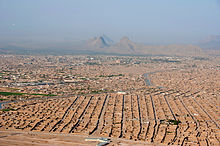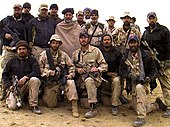Type a search term to find related articles by LIMS subject matter experts gathered from the most trusted and dynamic collaboration tools in the laboratory informatics industry.
| Fall of Kandahar | |||||||
|---|---|---|---|---|---|---|---|
| Part of the Afghan Civil War and the War in Afghanistan (2001–2021) | |||||||
 Aerial view of a section of Kandahar | |||||||
| |||||||
| Belligerents | |||||||
|
|
| ||||||
| Commanders and leaders | |||||||
|
|
| ||||||
| Strength | |||||||
|
3,000 Karzai militia[3] 350 Sharzai's militia[4] 800 Eastern Alliance 750 Americans 150 Australians |
Unknown number of Taliban fighters 300 Al-Qaeda fighters[4] | ||||||
| Casualties and losses | |||||||
|
Unknown Afghan losses 3 Americans killed | Unknown | ||||||
The Fall of Kandahar took place in 2001 during the War in Afghanistan. After the fall of Mazar-i-Sharif, Kabul and Herat, Kandahar was the last major city under Taliban control. Kandahar was where the Taliban movement had originated and where its power base was located, so it was assumed that capturing Kandahar would be difficult. The city fell after several weeks of fighting to a force of local militia under Pashtun military commanders and their American advisers. The fall of Kandahar signaled the end of organized Taliban control of Afghanistan.[5]
Kandahar was held by a mixed garrison of Taliban and al-Qaeda troops. The latter were led by Saif al-Adel and mostly consisted of a few hundred Arab mujahideen who had joined the movement in response to the U.S. bombings of Afghanistan.[2]

On 19 October 2001, Rangers from the 3rd Ranger Battalion (75th Ranger Regiment) departed from four Lockheed MC-130 aircraft towards a desert landing strip south of the city, codenamed "Objective Rhino", supported by 750 U.S. soldiers from the United States Army's 101st Airborne Division to create a forward base at Camp Rhino, 100 miles south of Kandahar.[citation needed]
Anti-Taliban commander Gul Agha Sherzai was contacted by a US Army Special Forces ODA on 18 November. His forces numbered about 800 men, but were severely outnumbered and under-equipped. After receiving supplies, they moved out on 22 November in a convoy of over 100 vehicles and began advancing on Kandahar through the Arghastan desert. Attempting to bypass Taliban strongholds, Sharzai's convoy halted outside the Taliban-held town of Takht-e-pol. While trying to negotiate a surrender, the convoy was ambushed by Taliban forces. Sharzai's forces drove the Taliban back with the help of American air support. The Taliban retreated and abandoned the Takht-e-pol area.[citation needed]
Before the 15th Marine Expeditionary Unit of the United States Marine Corps arrived at 'Rhino' on 25 November, a recce team from SEAL Team 8 carried out a reconnaissance mission, but were mistakenly engaged by AH-1W Cobra attack helicopters, they managed to get a message to the Marines before anyone was wounded.[6]
On 25 November, FOB (Forward Operating Base) Rhino was established outside of Kandahar, cleared in by the SEALs [7] the 15th MEU relieved the 101st Airborne Division of control of FOB Rhino and continued forward operations throughout Kandahar with coalition forces. On 27 November, the 15th MEU was joined by a unit of the Australian Special Air Service Regiment and began joint operations against Taliban forces.[citation needed]
After the Battle of Tarin Kowt, the Eastern Alliance, under the command of Hamid Karzai, spent several weeks in Tarin Kowt attracting recruits. His forces swelled to around 800 men as he prepared to move on Kandahar from the north. On 30 November, Karzai's force began advancing towards the town of Petaw. After taking Petaw without a fight, Karzai's force attempted to take the bridge at Sayd Alim Kalay but was halted by stiff Taliban resistance. After a two-day battle involving heavy airstrikes the Taliban withdrew on 4 December, leaving the bridge intact. Karzai's force seized a bridgehead on the other side.[citation needed]
The next day, a stray American bomb landed on an American position, killing three Special Forces soldiers and wounding Karzai. Karzai's men maintained their positions and began negotiations with the Taliban for the surrender of Kandahar.[citation needed]
On 7 December, Sherzai's men began their assault on Kandahar's airport, but met little resistance. They discovered that the Taliban had already surrendered the city to Karzai's forces. Sherzai's men entered the city and Sherzai was declared Governor of Kandahar. Karzai had already been declared Chairman of the Afghan Interim Administration, though he would not take office until 22 December.[8][9] Kandahar was fully secured by coalition forces by 9 December. The al-Qaeda troops under Saif al-Adel managed to retreat from the city, escaping to Pakistan.[2]
In the next two decades, Kandahar was repeatedly attacked by Taliban forces. The latter succeeded in retaking the city after a battle from July to August 2021 as part of a major offensive.[10]